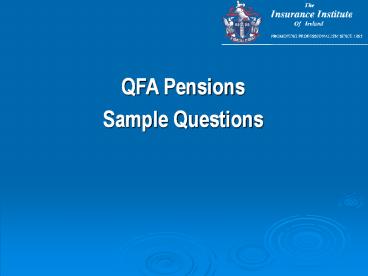QFA Pensions - PowerPoint PPT Presentation
1 / 21
Title:
QFA Pensions
Description:
A The State Pension System. B Personal Pension Provision. C Occupational ... D Nill. Sample Question. The State Invalidity Pension can NOT be claimed by: ... – PowerPoint PPT presentation
Number of Views:394
Avg rating:3.0/5.0
Title: QFA Pensions
1
QFA Pensions Sample Questions
2
Sample Question
The Third Pillar of provision for retirement
is A The State Pension System B Personal
Pension Provision C Occupational Pension
Schemes D Personal savings investments
3
Sample Question
Which one of the following is considered to be
unearned income? A Income from a part time
job B Rental income C Income from a self
employed trade D Income from a self employed
occupation
4
Sample Question
Which one of the following could be either
defined benefit or defined contribution? A
AVCs paid to a PRSA B AVCs paid to an
occupational pension scheme C A Personal Pension
Plan D A PRSA
5
Sample Question
Income from a self-employed trade is assessed
for Income Tax under A Schedule D, Case
I B Schedule F C Schedule E D Schedule D, Case
II
6
Sample Question
Which one of the following is NOT subject to
self-assessment for income Tax purposes? A A
Proprietary director whose only income is subject
of PAYE? B A self employed electrician C Anyone
over age 65 D An employee (not a director) whose
only income is subject to PAYE
7
Sample Question
A taxpayer subject to self-assessment must pay
(not using ROS online) preliminary income tax for
2006 by which date? A 31st October 2005 B 31st
December 2006 C 5th April 2006 D 31st October
2006
8
Sample Question
Dividends received by an individual from an
Irish company are assessed to income tax
under A Schedule D, Case I B Schedule F C
Schedule E D Schedule D, Case II
9
Sample Question
What Corporation TAX rate applies in 2006 to the
trading profits of companies? A
7.5 B 12.5 C 20 D 25
10
Sample Question
A proprietary director pays PRSI at which
class? A A B B C C D D
11
Sample Question
Mary has received an inheritance of 600,000 from
her Father in September 2006. Earlier in 2006
she received a separate inheritance of 200,000
from her Aunt (i.e. her mothers sister). Prior
to 2006 she had not received any other gift or
inheritance from any source. What
inheritance Tax, if any, does Mary have to pay on
the inheritance received from her
Father? A 64,369 B 120,000 C 24,369 D Nill
12
Sample Question
The State Invalidity Pension can NOT be claimed
by A Proprietary directors B Civil Servants
recruited after 6th April 1995 C Part time
employees in the private sector D Full time
employees in the private sector
13
Sample Question
Entitlement to which one of the following State
Pensions is subject to a means test? A State
Pension (Transition) B State Pension
(Contributory) C State Pension (Non
Contributory) D State Widows Pension
(Contributory)
14
Sample Question
At what age does the State Pension (Transition)
become payable? A 65 B 66 C 67 D 70
15
Sample Question
John is in pension able employment and
contributes 5 pa of his 100,000 pa pensionable
earnings to his employers pension scheme. He
also has separate self employed net relevant
earnings of 250,000 pa. John is aged 48. What
is the maximum Personal Pension Plan contribution
he can get tax relief on in 2006, assuming he
contributes to no other pension arrangement in
2006? A 38, 500 B 62, 500 C 76,
200 D 46, 200
16
Sample Question
- The benefit payable under a Permanent Health
- Insurance policy is
- A Tax Free
- B Subject to exit tax
- C Liable to Income tax
- D Tax free up to annual limit of 12, 700 pa
17
Sample Question
What is the limit for tax relief on Permanent
Health Insurance (PHI) premiums? A 10 pa of
income B 15 pa of income C 15 pa of income,
increasing at age 30 and over D 5 pa of
income
18
Sample Question
What is the latest age at which an individual
must normally take retirement benefits from a
Personal Pension Plan? A 70th birthday B 75th
birthday C 55th birthday D 65th birthday
19
Sample Question
The Proceeds on death of a Section 785 life
assurance policy are payable to A The
deceaseds next of kin B The deceaseds
spouse C Trustees of the policy D The deceaseds
estate
20
Sample Question
John is now retiring and drawing on his Personal
Pension Plan. The Plan has an accumulated value
of 250,000 Assuming John is not currently
receiving any other pension income, and has not
previously invested in an AMRF or annuity, what
is the maximum amount John can transfer to an ARF
from the proceeds of the Personal Pension
Plan. A 62,500 B 63, 500 C 124,000 D 187,500
21
Sample Question
What is the maximum guarantee period a pension
arising under a Personal Pension Plan can
have? A 10 yrs B 5 yrs C 3 yrs D 20 yrs































